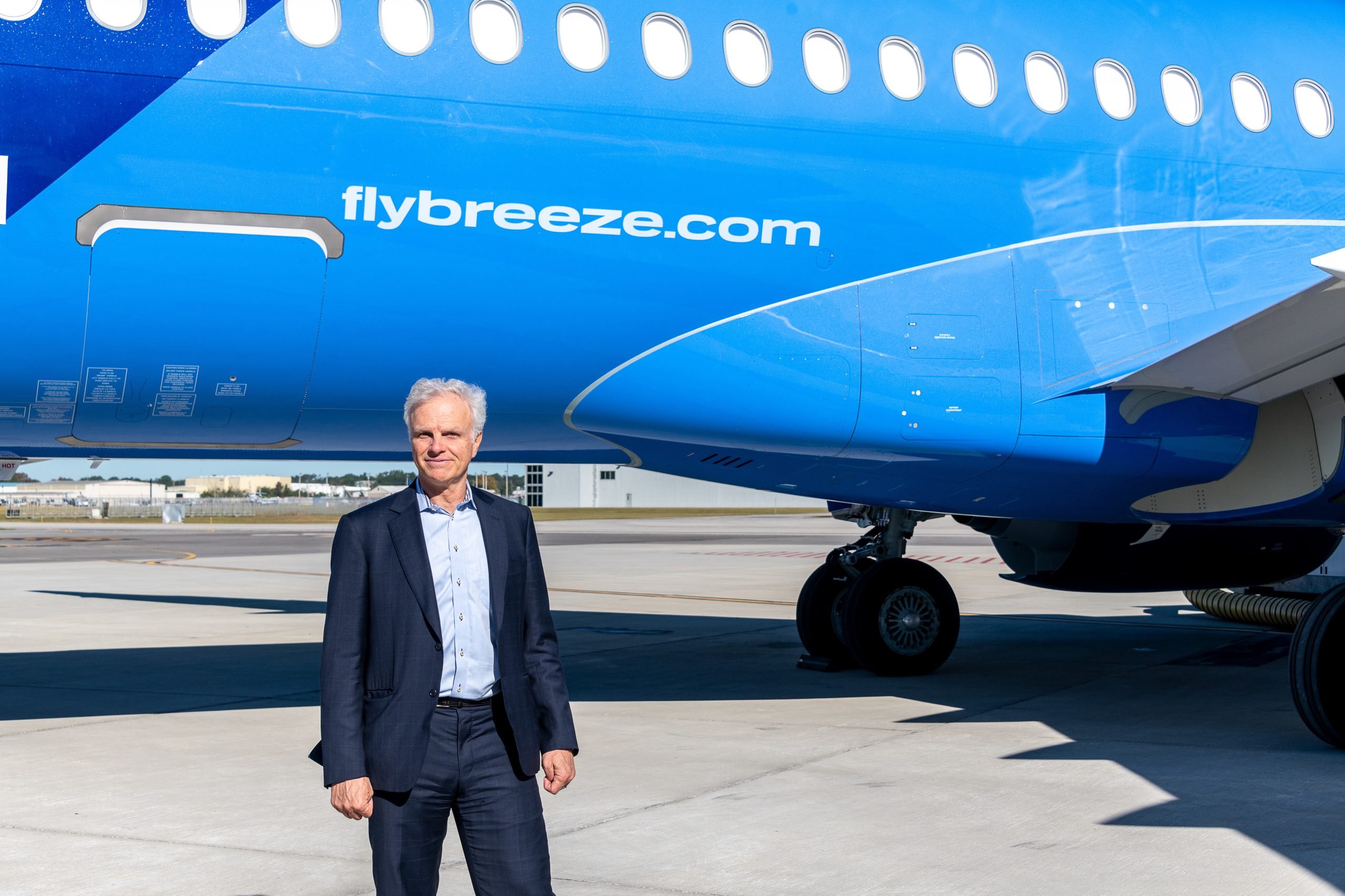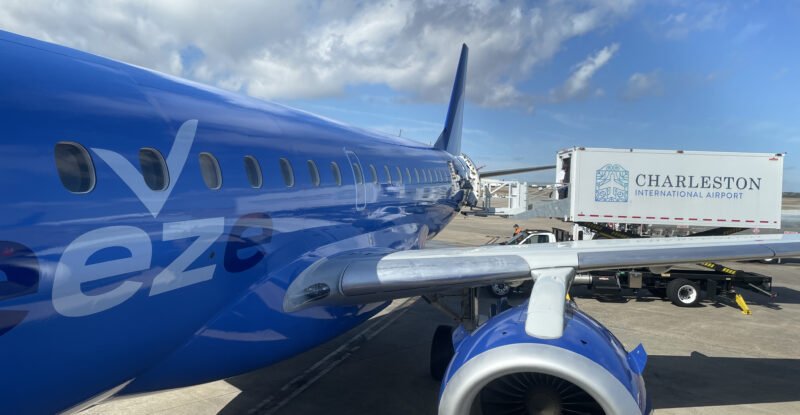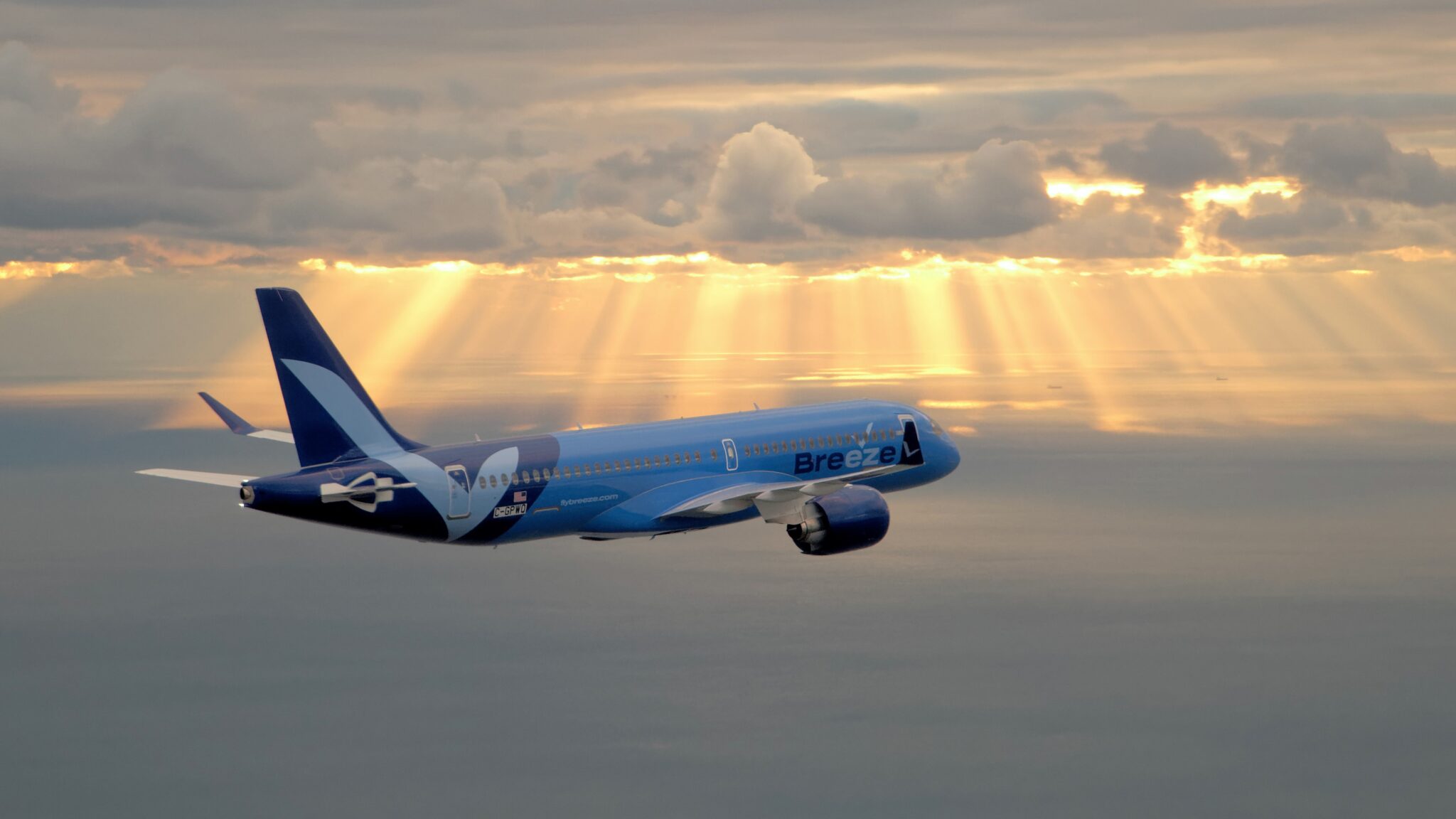David Neeleman can’t stop moving. The 62-year-old airline entrepreneur has joined a Zoom interview from his home in Utah. Holding his iPhone in the vicinity of his face, he wanders restlessly from room to room, sometimes sitting for a moment, then jumping up again, as if trying to catch up with the words that rush from his mouth. Talking with Neeleman feels a bit like stepping onto an airport conveyor walkway—it was moving before you got there, and it’ll be moving after you leave.
Neeleman has founded or helped to found five airlines. In the 1980s, he cofounded Morris Air, a low-cost charter airline. In the early 1990s, he helped launch Canada’s WestJet. Then, in 1998, he founded JetBlue, which, with its low fares and emphasis on “bringing humanity back to air travel,” brought a new and cool attitude to the U.S. airline industry. In 2008, he went to Brazil to launch Azul, which raised the bar for air service in that country. And now comes Breeze Airways, which began flying in mid-2021. Five airlines in an industry where profits are notoriously hard to find is a remarkable feat, and I wanted to know why Neeleman kept starting airlines.


“I don’t do it just for the sake of doing it,” he tells Worth. “I have to look at a need.” With JetBlue, which began flying with New York’s John F. Kennedy Airport as its base, “JFK was wide open,” Neeleman explains. “Nobody was there. Brazil, there was a huge need. I would say that Azul is the thing I’m most proud of—creating all that—until now.”
If you haven’t heard of Breeze, that’s probably because it launched about a year into the COVID pandemic and flew largely, well, under the radar, given what else was going on in the world. Another reason might have to do with where Breeze flies to and from. The need that Neeleman saw wasn’t about flying passengers in and out of big cities. Looking across the map of the United States—and scanning passenger data from the U.S. Department of Transportation—Neeleman saw a network of small to mid-sized cities that were almost impossible to fly between on a direct flight. So, he decided to connect them.
As of this writing, Breeze offers direct flights from and to 28 cities in 18 states—places like Bentonville, Arkansas; Charleston, South Carolina; Hartford, Connecticut; Huntsville, Alabama; Norfolk, Virginia; Providence, Rhode Island; Richmond, Virginia; and Tampa, Florida. In demographer-speak, these are “second-tier” cities. They have a smaller population and lesser economic output than places like New York, Miami or Los Angeles. Plus, they don’t typically get a lot of attention from the national media.

But in the past decade or so, many of these cities have been rising, attracting new residents seeking a better quality of life in a small city and businesses incentivized by lower costs, taxes and regulation. Many of these cities have cultural offerings—restaurants, museums, clubs—that, in quality if not scale, are just as compelling as those of big cities. The pandemic made those cities even more appealing. “COVID changed a lot of people’s perceptions about where they can live, and also their ability to work remotely,” says Kellie Wright, chief marketing officer at the Rhode Island Airport Corporation.
But flying back and forth among these second-tier cities has always been a challenge, typically involving changing to a small plane at a hub such as New York, Atlanta or Chicago. “Ninety-five percent of Breeze routes previously had no airline serving them nonstop,” says Lukas Johnson, Breeze’s chief commercial officer.
A former actuary, Johnson helped design Breeze’s route map. “If you’re flying American, Delta or United, you’ve got large planes and small regional jets and not a lot in between,” Johnson says. “Bigger planes mean you have to fly to bigger places” in order to fill seats. Breeze, however, began by flying Embraer 195s outfitted with around 118 seats (none of which are middle seats)—a sweet spot between larger jets and regional planes.
For the cities involved, Breeze is a powerful economic accelerant. First, it creates a tourism market that largely didn’t exist previously. “Breeze has given us new nonstop service to markets that we didn’t have access to before,” says Helen Hill, the CEO of Explore Charleston, the city’s destination and marketing organization. “And we know that we can create a market when there’s access.” An added bonus of these new markets? First-time visitors to a city tend to stay longer and spend more.

“Take Richmond, Virginia,” Hill says. “It’s a great market for Charleston, with people interested in history, food, beaches”—all reasons why millions of people visit Charleston every year. “But it’s a really long way to drive” from Richmond to Charleston. “All of a sudden, [Richmond residents] have an opportunity to come here.”
Other cities are forming connections that wouldn’t make sense without direct air travel. Norfolk, Virginia, and Newport, Rhode Island, both have outstanding jazz festivals at different times of the year, but “jazz fans in Norfolk really didn’t have an easy way to get to Newport” and vice-versa, says Kurt Krause, president and CEO of Visit Norfolk. Now, Norfolk is working with the Rhode Island T.F. Green International Airport to create bilateral marketing efforts. “There’s a partnership there that wouldn’t have happened without Breeze.”
It helps that ticket prices on Breeze can be startlingly low. Emily Nipps, director of communications at Tampa International Airport, recently flew to Charleston—her first time there. The total cost for two round-trip tickets to take her daughter and herself: $156. Now, Nipps says, “I’m looking at Breeze thinking, ‘Tulsa. I’ve never been to Tulsa.’”
Breeze doesn’t really compete with other airlines, Lukas Johnson argues. “Frankly, we compete with the couch, with people choosing to spend their money on some leisure activity in their hometown. But if I tell you that you’re going to the beach for $60 instead of going bowling…That gets people jumping out of their seat.”
In addition to low fares, Breeze also emphasizes its culture of “nice.” The seats, for instance, are ranked as “Nice,” “Nicer” and “Nicest.” Sign up to receive emails from Breeze, and you get a prompt that says, “It’s Nice to Meet You!” According to Breeze’s head of corporate communications Gareth Edmondson-Jones, “We are doing everything we can to make everybody happy and delivering seriously nice.” That means cheery crew members and a policy that lets passengers change flights up to 15 minutes before takeoff without a fee, and credits for cancellations last for two years rather than the industry-standard one. Also, in the name of niceness, Breeze has eliminated customers’ ability to call the airline over the telephone, requiring customers reach out through email or text. That eliminates long hold times, Neeleman says. “If you can’t do [phone service] well, you just don’t want to do it.” On Facebook, at least, early passenger reviews of the policy are mixed. Though many passengers lauded Breeze’s low fares, clean planes and friendly flight crews, others lamented the lack of a phone number, citing hours-long wait times for responses to texts and emails that didn’t always address their questions. “If you’re ever waiting for hours for a response from Breeze, that’s an aberration,” says Edmondson-Jones. “Our average response time is under 20 minutes.”
Many of the cities that Breeze flies to have a corporate presence that supports these new flights. Hartford and Providence are both physically close to Connecticut defense manufacturer General Dynamics, which also has operations in Norfolk. Bentonville has Walmart. Huntsville has a plethora of aerospace and defense contractors, such as Boeing, Blue Origin, Northrop Grumman and Lockheed Martin. Richmond has 12 Fortune 1000 headquarters, including Altria Group and CarMax. “Having direct flights is critical to economic development and business,” says Jennifer Wakefield, president and CEO of economic development group Greater Richmond Partnership. “Companies want to be able to get where they need to go without flying to other locations.”
“There’s no doubt—the easier you connect your community to the rest of the country, the more lucrative your location becomes,” says Kevin Dillon, executive director and CEO of the Connecticut Airport Authority. “From a business retention standpoint and certainly for attracting new industry, it’s very important.”
“Every time we go into these cities,” David Neeleman says, “we get a hero’s welcome.”
In the months ahead, Breeze plans to grow quickly, adding new cities and larger planes, Airbus A220s—Neeleman calls them “the most advanced airplane in the sky”—that have a longer range and more seating capacity than the Embraer jets. It’s also started a charter aviation service for large groups using its Embraer jets. “Breeze has just been amazing,” Neeleman says. “It’s going to accomplish great things.”







